change time BMW M5 2015 F10M User Guide
[x] Cancel search | Manufacturer: BMW, Model Year: 2015, Model line: M5, Model: BMW M5 2015 F10MPages: 239, PDF Size: 5.04 MB
Page 150 of 239
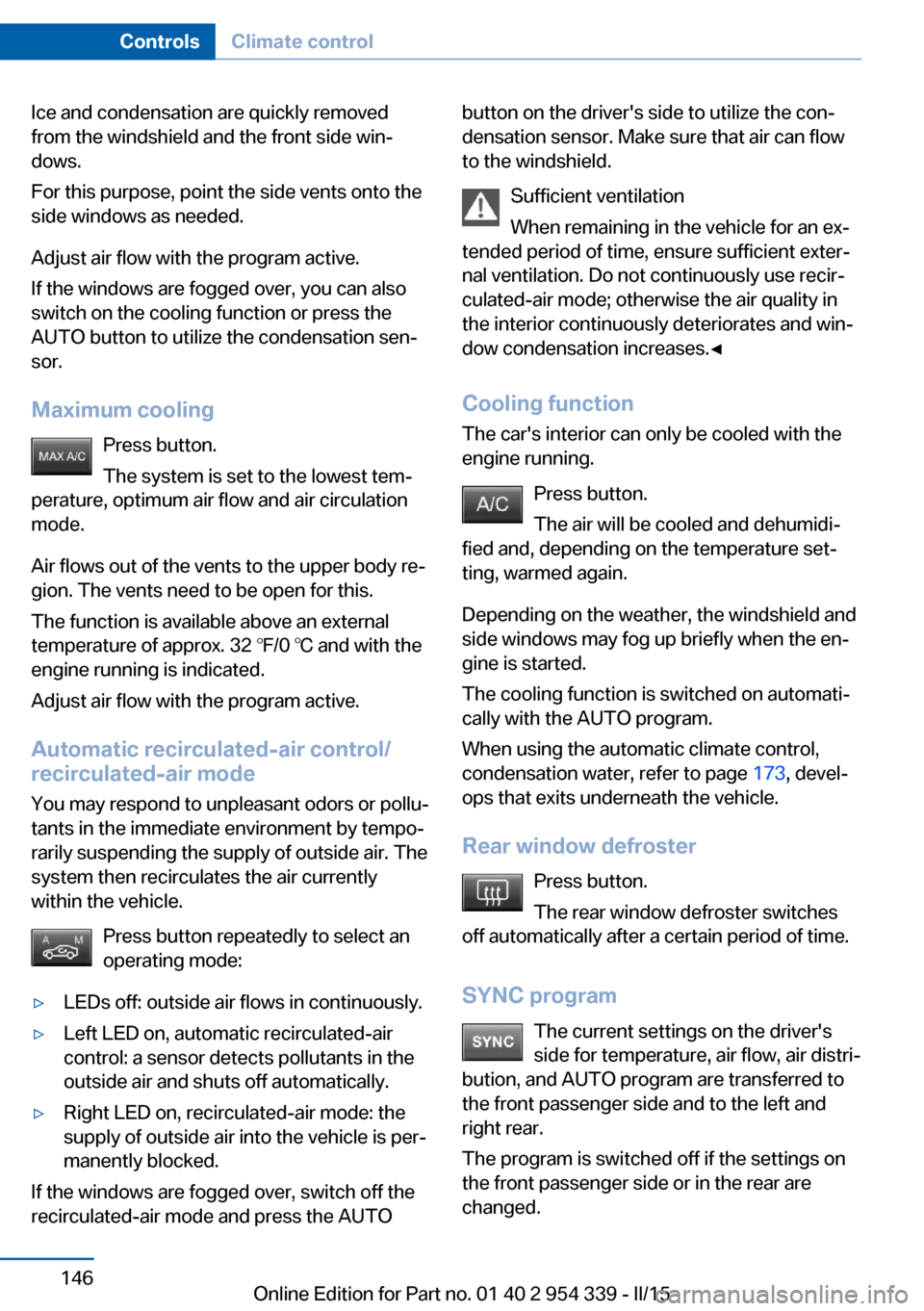
Ice and condensation are quickly removed
from the windshield and the front side win‐
dows.
For this purpose, point the side vents onto the
side windows as needed.
Adjust air flow with the program active.
If the windows are fogged over, you can also
switch on the cooling function or press the
AUTO button to utilize the condensation sen‐
sor.
Maximum cooling Press button.
The system is set to the lowest tem‐
perature, optimum air flow and air circulation mode.
Air flows out of the vents to the upper body re‐
gion. The vents need to be open for this.
The function is available above an external
temperature of approx. 32 ℉/0 ℃ and with the
engine running is indicated.
Adjust air flow with the program active.
Automatic recirculated-air control/
recirculated-air mode
You may respond to unpleasant odors or pollu‐
tants in the immediate environment by tempo‐
rarily suspending the supply of outside air. The
system then recirculates the air currently
within the vehicle.
Press button repeatedly to select an
operating mode:▷LEDs off: outside air flows in continuously.▷Left LED on, automatic recirculated-air
control: a sensor detects pollutants in the
outside air and shuts off automatically.▷Right LED on, recirculated-air mode: the
supply of outside air into the vehicle is per‐
manently blocked.
If the windows are fogged over, switch off the
recirculated-air mode and press the AUTO
button on the driver's side to utilize the con‐
densation sensor. Make sure that air can flow
to the windshield.
Sufficient ventilation
When remaining in the vehicle for an ex‐
tended period of time, ensure sufficient exter‐
nal ventilation. Do not continuously use recir‐
culated-air mode; otherwise the air quality in
the interior continuously deteriorates and win‐
dow condensation increases.◀
Cooling function The car's interior can only be cooled with the
engine running.
Press button.
The air will be cooled and dehumidi‐
fied and, depending on the temperature set‐
ting, warmed again.
Depending on the weather, the windshield and
side windows may fog up briefly when the en‐
gine is started.
The cooling function is switched on automati‐
cally with the AUTO program.
When using the automatic climate control,
condensation water, refer to page 173, devel‐
ops that exits underneath the vehicle.
Rear window defroster Press button.
The rear window defroster switches
off automatically after a certain period of time.
SYNC program The current settings on the driver's
side for temperature, air flow, air distri‐
bution, and AUTO program are transferred to the front passenger side and to the left and
right rear.
The program is switched off if the settings on
the front passenger side or in the rear are
changed.Seite 146ControlsClimate control146
Online Edition for Part no. 01 40 2 954 339 - II/15
Page 153 of 239
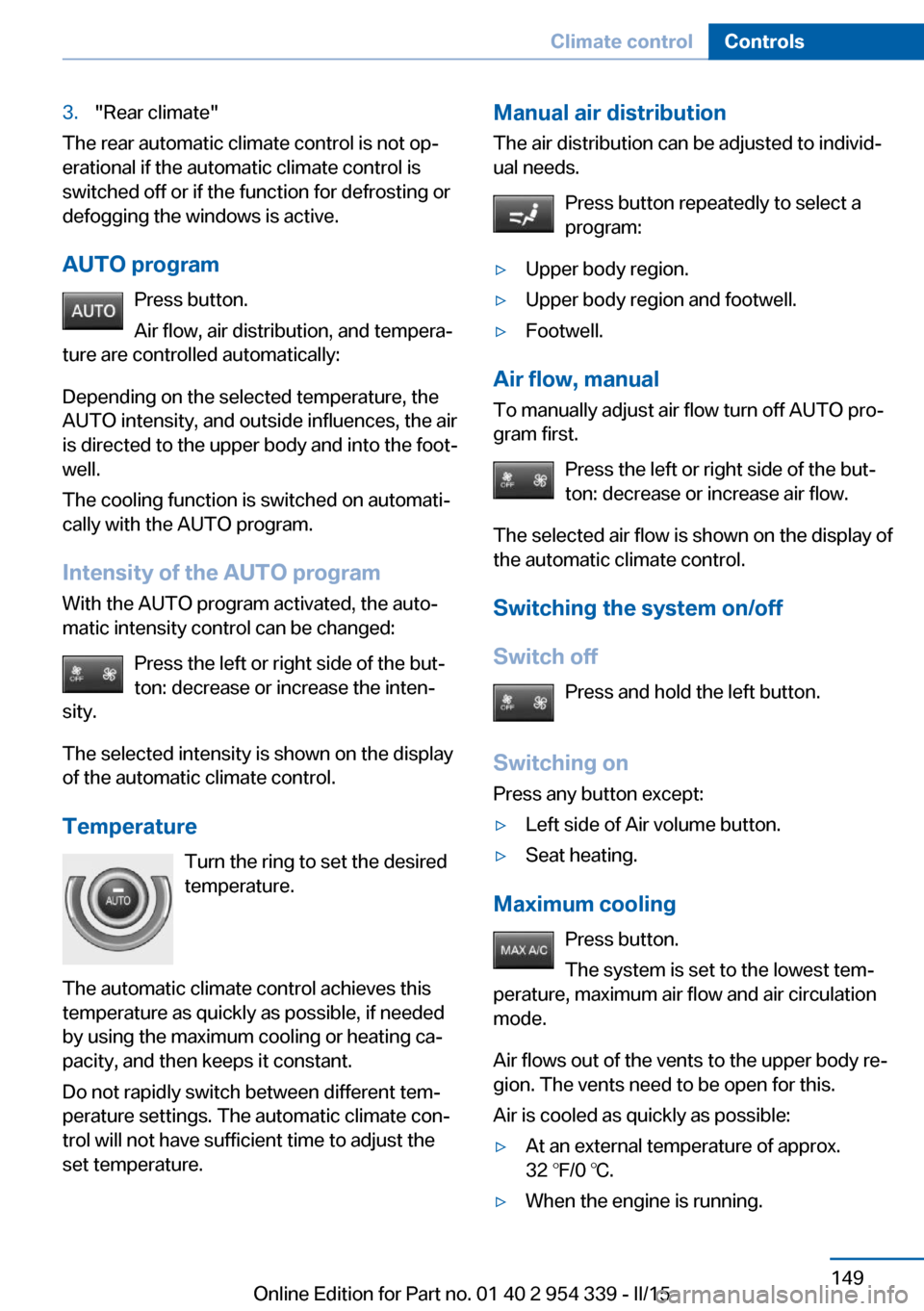
3."Rear climate"
The rear automatic climate control is not op‐
erational if the automatic climate control is
switched off or if the function for defrosting or
defogging the windows is active.
AUTO program Press button.
Air flow, air distribution, and tempera‐
ture are controlled automatically:
Depending on the selected temperature, the
AUTO intensity, and outside influences, the air
is directed to the upper body and into the foot‐
well.
The cooling function is switched on automati‐
cally with the AUTO program.
Intensity of the AUTO program With the AUTO program activated, the auto‐
matic intensity control can be changed:
Press the left or right side of the but‐
ton: decrease or increase the inten‐
sity.
The selected intensity is shown on the display
of the automatic climate control.
Temperature Turn the ring to set the desired
temperature.
The automatic climate control achieves this
temperature as quickly as possible, if needed
by using the maximum cooling or heating ca‐
pacity, and then keeps it constant.
Do not rapidly switch between different tem‐
perature settings. The automatic climate con‐
trol will not have sufficient time to adjust the
set temperature.
Manual air distribution
The air distribution can be adjusted to individ‐
ual needs.
Press button repeatedly to select a
program:▷Upper body region.▷Upper body region and footwell.▷Footwell.
Air flow, manual
To manually adjust air flow turn off AUTO pro‐
gram first.
Press the left or right side of the but‐
ton: decrease or increase air flow.
The selected air flow is shown on the display of
the automatic climate control.
Switching the system on/off
Switch off Press and hold the left button.
Switching on Press any button except:
▷Left side of Air volume button.▷Seat heating.
Maximum cooling
Press button.
The system is set to the lowest tem‐
perature, maximum air flow and air circulation
mode.
Air flows out of the vents to the upper body re‐
gion. The vents need to be open for this.
Air is cooled as quickly as possible:
▷At an external temperature of approx.
32 ℉/0 ℃.▷When the engine is running.Seite 149Climate controlControls149
Online Edition for Part no. 01 40 2 954 339 - II/15
Page 156 of 239
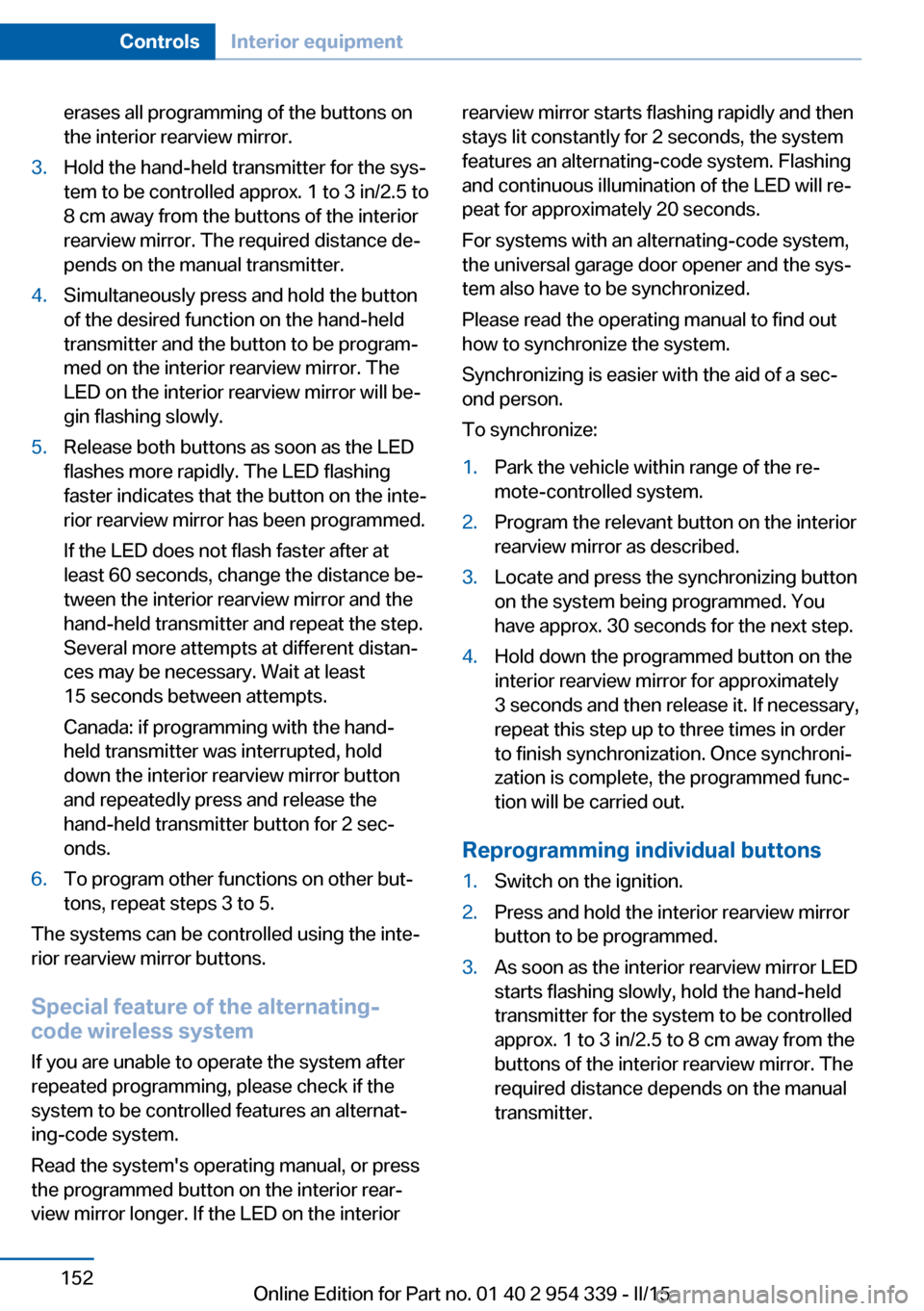
erases all programming of the buttons on
the interior rearview mirror.3.Hold the hand-held transmitter for the sys‐
tem to be controlled approx. 1 to 3 in/2.5 to
8 cm away from the buttons of the interior
rearview mirror. The required distance de‐
pends on the manual transmitter.4.Simultaneously press and hold the button
of the desired function on the hand-held
transmitter and the button to be program‐
med on the interior rearview mirror. The
LED on the interior rearview mirror will be‐
gin flashing slowly.5.Release both buttons as soon as the LED
flashes more rapidly. The LED flashing
faster indicates that the button on the inte‐
rior rearview mirror has been programmed.
If the LED does not flash faster after at
least 60 seconds, change the distance be‐
tween the interior rearview mirror and the
hand-held transmitter and repeat the step.
Several more attempts at different distan‐
ces may be necessary. Wait at least
15 seconds between attempts.
Canada: if programming with the hand-
held transmitter was interrupted, hold
down the interior rearview mirror button
and repeatedly press and release the
hand-held transmitter button for 2 sec‐
onds.6.To program other functions on other but‐
tons, repeat steps 3 to 5.
The systems can be controlled using the inte‐
rior rearview mirror buttons.
Special feature of the alternating-
code wireless system
If you are unable to operate the system after
repeated programming, please check if the
system to be controlled features an alternat‐
ing-code system.
Read the system's operating manual, or press
the programmed button on the interior rear‐
view mirror longer. If the LED on the interior
rearview mirror starts flashing rapidly and then
stays lit constantly for 2 seconds, the system
features an alternating-code system. Flashing
and continuous illumination of the LED will re‐
peat for approximately 20 seconds.
For systems with an alternating-code system,
the universal garage door opener and the sys‐
tem also have to be synchronized.
Please read the operating manual to find out how to synchronize the system.
Synchronizing is easier with the aid of a sec‐
ond person.
To synchronize:1.Park the vehicle within range of the re‐
mote-controlled system.2.Program the relevant button on the interior
rearview mirror as described.3.Locate and press the synchronizing button
on the system being programmed. You
have approx. 30 seconds for the next step.4.Hold down the programmed button on the
interior rearview mirror for approximately
3 seconds and then release it. If necessary,
repeat this step up to three times in order
to finish synchronization. Once synchroni‐
zation is complete, the programmed func‐
tion will be carried out.
Reprogramming individual buttons
1.Switch on the ignition.2.Press and hold the interior rearview mirror
button to be programmed.3.As soon as the interior rearview mirror LED
starts flashing slowly, hold the hand-held
transmitter for the system to be controlled
approx. 1 to 3 in/2.5 to 8 cm away from the
buttons of the interior rearview mirror. The
required distance depends on the manual
transmitter.Seite 152ControlsInterior equipment152
Online Edition for Part no. 01 40 2 954 339 - II/15
Page 208 of 239
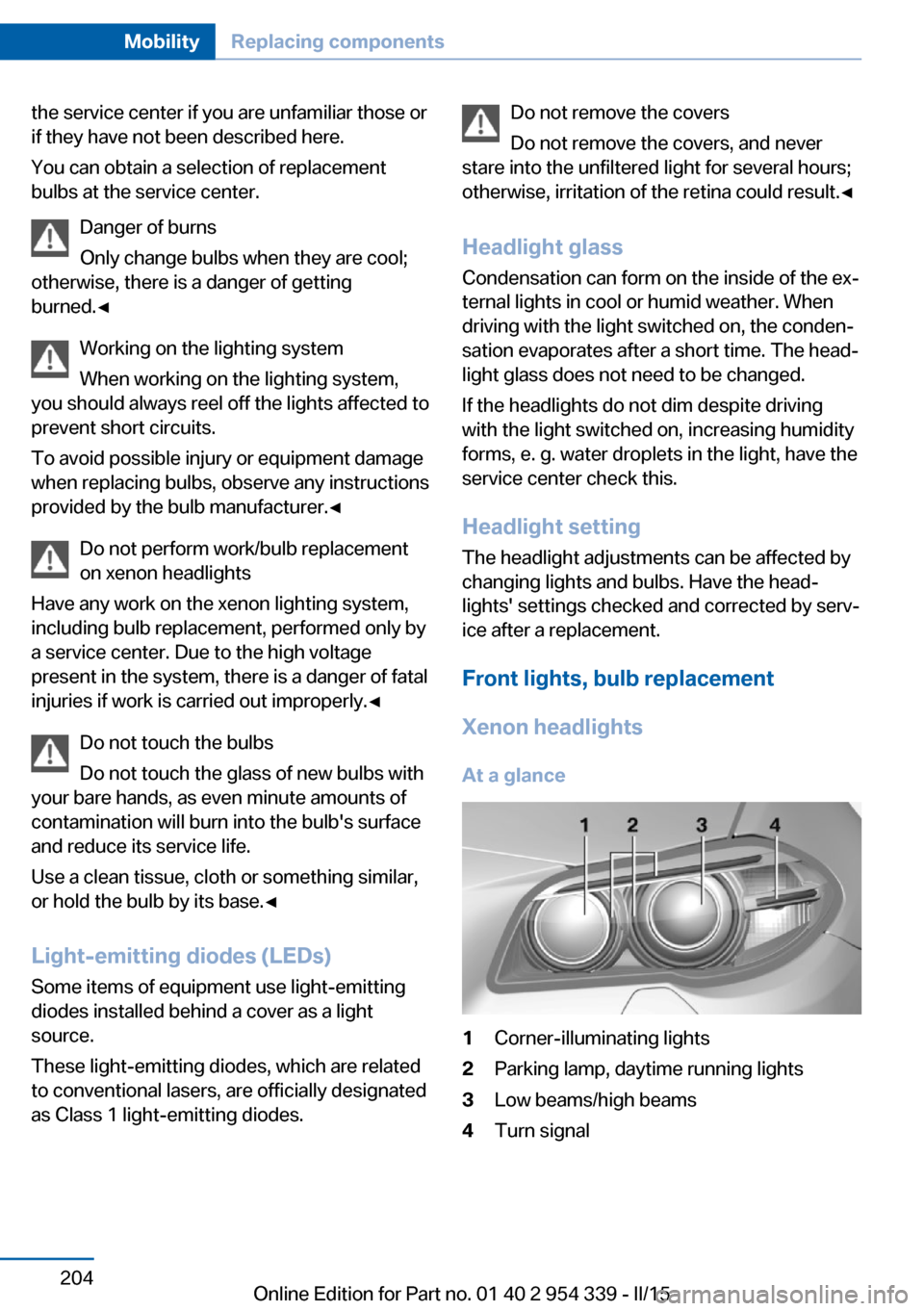
the service center if you are unfamiliar those or
if they have not been described here.
You can obtain a selection of replacement
bulbs at the service center.
Danger of burns
Only change bulbs when they are cool;
otherwise, there is a danger of getting
burned.◀
Working on the lighting system
When working on the lighting system,
you should always reel off the lights affected to
prevent short circuits.
To avoid possible injury or equipment damage
when replacing bulbs, observe any instructions
provided by the bulb manufacturer.◀
Do not perform work/bulb replacement
on xenon headlights
Have any work on the xenon lighting system,
including bulb replacement, performed only by
a service center. Due to the high voltage
present in the system, there is a danger of fatal
injuries if work is carried out improperly.◀
Do not touch the bulbs
Do not touch the glass of new bulbs with
your bare hands, as even minute amounts of
contamination will burn into the bulb's surface
and reduce its service life.
Use a clean tissue, cloth or something similar,
or hold the bulb by its base.◀
Light-emitting diodes (LEDs)
Some items of equipment use light-emitting
diodes installed behind a cover as a light
source.
These light-emitting diodes, which are related
to conventional lasers, are officially designated as Class 1 light-emitting diodes.Do not remove the covers
Do not remove the covers, and never
stare into the unfiltered light for several hours;
otherwise, irritation of the retina could result.◀
Headlight glass
Condensation can form on the inside of the ex‐
ternal lights in cool or humid weather. When
driving with the light switched on, the conden‐
sation evaporates after a short time. The head‐
light glass does not need to be changed.
If the headlights do not dim despite driving
with the light switched on, increasing humidity
forms, e. g. water droplets in the light, have the service center check this.
Headlight setting The headlight adjustments can be affected by
changing lights and bulbs. Have the head‐
lights' settings checked and corrected by serv‐
ice after a replacement.
Front lights, bulb replacement
Xenon headlights
At a glance1Corner-illuminating lights2Parking lamp, daytime running lights3Low beams/high beams4Turn signalSeite 204MobilityReplacing components204
Online Edition for Part no. 01 40 2 954 339 - II/15
Page 229 of 239
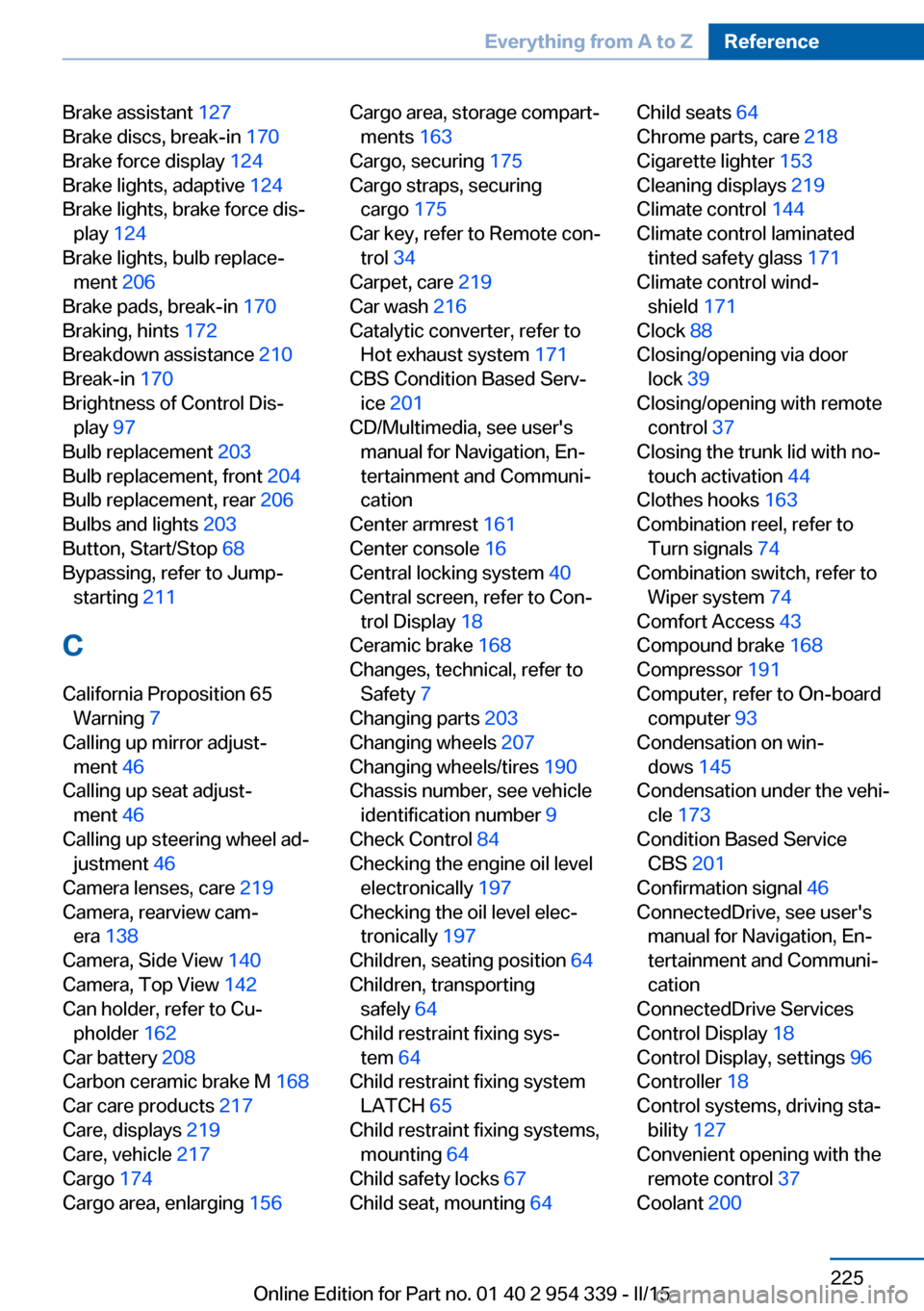
Brake assistant 127
Brake discs, break-in 170
Brake force display 124
Brake lights, adaptive 124
Brake lights, brake force dis‐ play 124
Brake lights, bulb replace‐ ment 206
Brake pads, break-in 170
Braking, hints 172
Breakdown assistance 210
Break-in 170
Brightness of Control Dis‐ play 97
Bulb replacement 203
Bulb replacement, front 204
Bulb replacement, rear 206
Bulbs and lights 203
Button, Start/Stop 68
Bypassing, refer to Jump- starting 211
C
California Proposition 65 Warning 7
Calling up mirror adjust‐ ment 46
Calling up seat adjust‐ ment 46
Calling up steering wheel ad‐ justment 46
Camera lenses, care 219
Camera, rearview cam‐ era 138
Camera, Side View 140
Camera, Top View 142
Can holder, refer to Cu‐ pholder 162
Car battery 208
Carbon ceramic brake M 168
Car care products 217
Care, displays 219
Care, vehicle 217
Cargo 174
Cargo area, enlarging 156 Cargo area, storage compart‐
ments 163
Cargo, securing 175
Cargo straps, securing cargo 175
Car key, refer to Remote con‐ trol 34
Carpet, care 219
Car wash 216
Catalytic converter, refer to Hot exhaust system 171
CBS Condition Based Serv‐ ice 201
CD/Multimedia, see user's manual for Navigation, En‐
tertainment and Communi‐
cation
Center armrest 161
Center console 16
Central locking system 40
Central screen, refer to Con‐ trol Display 18
Ceramic brake 168
Changes, technical, refer to Safety 7
Changing parts 203
Changing wheels 207
Changing wheels/tires 190
Chassis number, see vehicle identification number 9
Check Control 84
Checking the engine oil level electronically 197
Checking the oil level elec‐ tronically 197
Children, seating position 64
Children, transporting safely 64
Child restraint fixing sys‐ tem 64
Child restraint fixing system LATCH 65
Child restraint fixing systems, mounting 64
Child safety locks 67
Child seat, mounting 64 Child seats 64
Chrome parts, care 218
Cigarette lighter 153
Cleaning displays 219
Climate control 144
Climate control laminated tinted safety glass 171
Climate control wind‐ shield 171
Clock 88
Closing/opening via door lock 39
Closing/opening with remote control 37
Closing the trunk lid with no- touch activation 44
Clothes hooks 163
Combination reel, refer to Turn signals 74
Combination switch, refer to Wiper system 74
Comfort Access 43
Compound brake 168
Compressor 191
Computer, refer to On-board computer 93
Condensation on win‐ dows 145
Condensation under the vehi‐ cle 173
Condition Based Service CBS 201
Confirmation signal 46
ConnectedDrive, see user's manual for Navigation, En‐
tertainment and Communi‐
cation
ConnectedDrive Services
Control Display 18
Control Display, settings 96
Controller 18
Control systems, driving sta‐ bility 127
Convenient opening with the remote control 37
Coolant 200 Seite 225Everything from A to ZReference225
Online Edition for Part no. 01 40 2 954 339 - II/15
Page 230 of 239
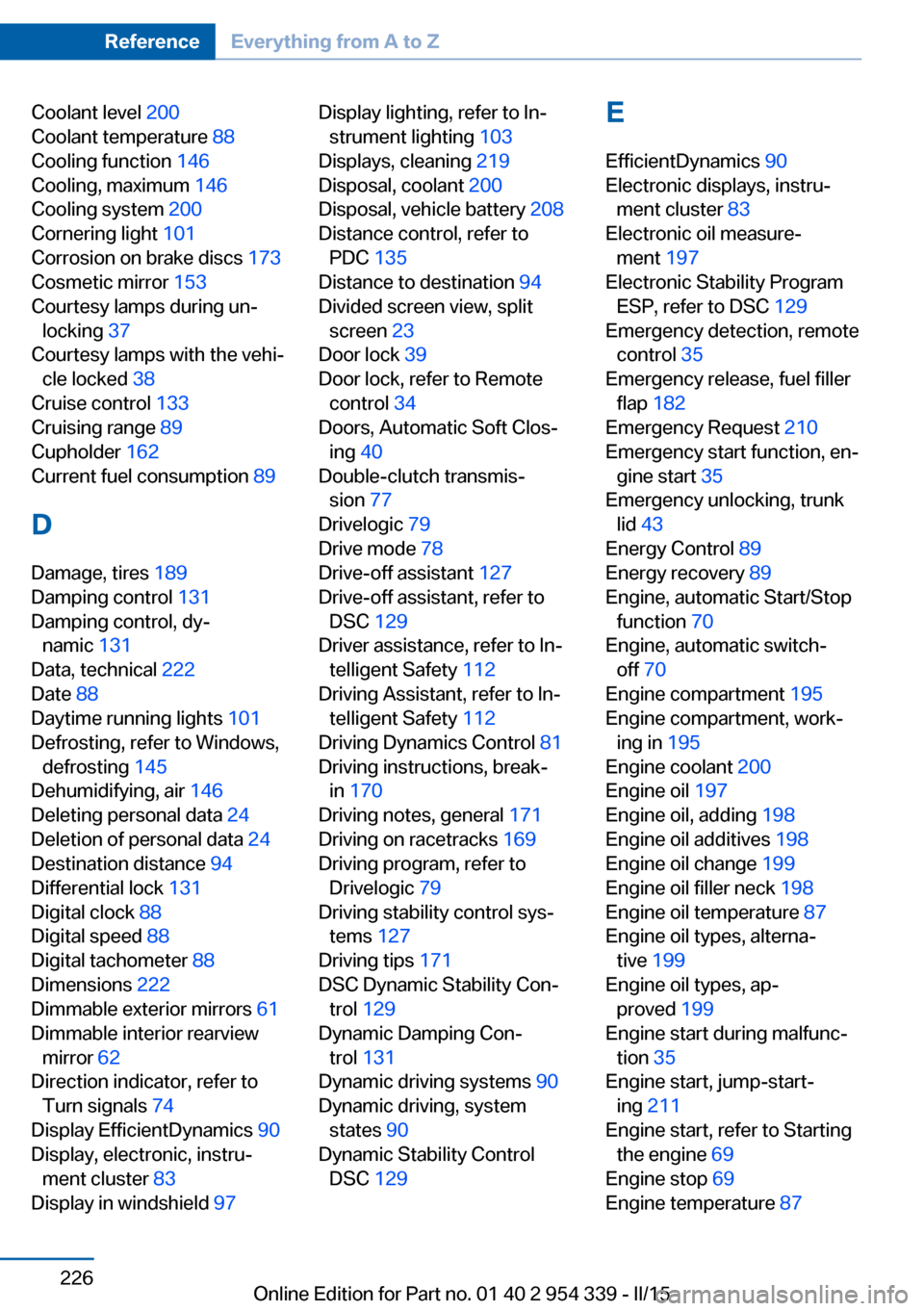
Coolant level 200
Coolant temperature 88
Cooling function 146
Cooling, maximum 146
Cooling system 200
Cornering light 101
Corrosion on brake discs 173
Cosmetic mirror 153
Courtesy lamps during un‐ locking 37
Courtesy lamps with the vehi‐ cle locked 38
Cruise control 133
Cruising range 89
Cupholder 162
Current fuel consumption 89
D
Damage, tires 189
Damping control 131
Damping control, dy‐ namic 131
Data, technical 222
Date 88
Daytime running lights 101
Defrosting, refer to Windows, defrosting 145
Dehumidifying, air 146
Deleting personal data 24
Deletion of personal data 24
Destination distance 94
Differential lock 131
Digital clock 88
Digital speed 88
Digital tachometer 88
Dimensions 222
Dimmable exterior mirrors 61
Dimmable interior rearview mirror 62
Direction indicator, refer to Turn signals 74
Display EfficientDynamics 90
Display, electronic, instru‐ ment cluster 83
Display in windshield 97 Display lighting, refer to In‐
strument lighting 103
Displays, cleaning 219
Disposal, coolant 200
Disposal, vehicle battery 208
Distance control, refer to PDC 135
Distance to destination 94
Divided screen view, split screen 23
Door lock 39
Door lock, refer to Remote control 34
Doors, Automatic Soft Clos‐ ing 40
Double-clutch transmis‐ sion 77
Drivelogic 79
Drive mode 78
Drive-off assistant 127
Drive-off assistant, refer to DSC 129
Driver assistance, refer to In‐ telligent Safety 112
Driving Assistant, refer to In‐ telligent Safety 112
Driving Dynamics Control 81
Driving instructions, break- in 170
Driving notes, general 171
Driving on racetracks 169
Driving program, refer to Drivelogic 79
Driving stability control sys‐ tems 127
Driving tips 171
DSC Dynamic Stability Con‐ trol 129
Dynamic Damping Con‐ trol 131
Dynamic driving systems 90
Dynamic driving, system states 90
Dynamic Stability Control DSC 129 E
EfficientDynamics 90
Electronic displays, instru‐ ment cluster 83
Electronic oil measure‐ ment 197
Electronic Stability Program ESP, refer to DSC 129
Emergency detection, remote control 35
Emergency release, fuel filler flap 182
Emergency Request 210
Emergency start function, en‐ gine start 35
Emergency unlocking, trunk lid 43
Energy Control 89
Energy recovery 89
Engine, automatic Start/Stop function 70
Engine, automatic switch- off 70
Engine compartment 195
Engine compartment, work‐ ing in 195
Engine coolant 200
Engine oil 197
Engine oil, adding 198
Engine oil additives 198
Engine oil change 199
Engine oil filler neck 198
Engine oil temperature 87
Engine oil types, alterna‐ tive 199
Engine oil types, ap‐ proved 199
Engine start during malfunc‐ tion 35
Engine start, jump-start‐ ing 211
Engine start, refer to Starting the engine 69
Engine stop 69
Engine temperature 87 Seite 226ReferenceEverything from A to Z226
Online Edition for Part no. 01 40 2 954 339 - II/15
Page 235 of 239
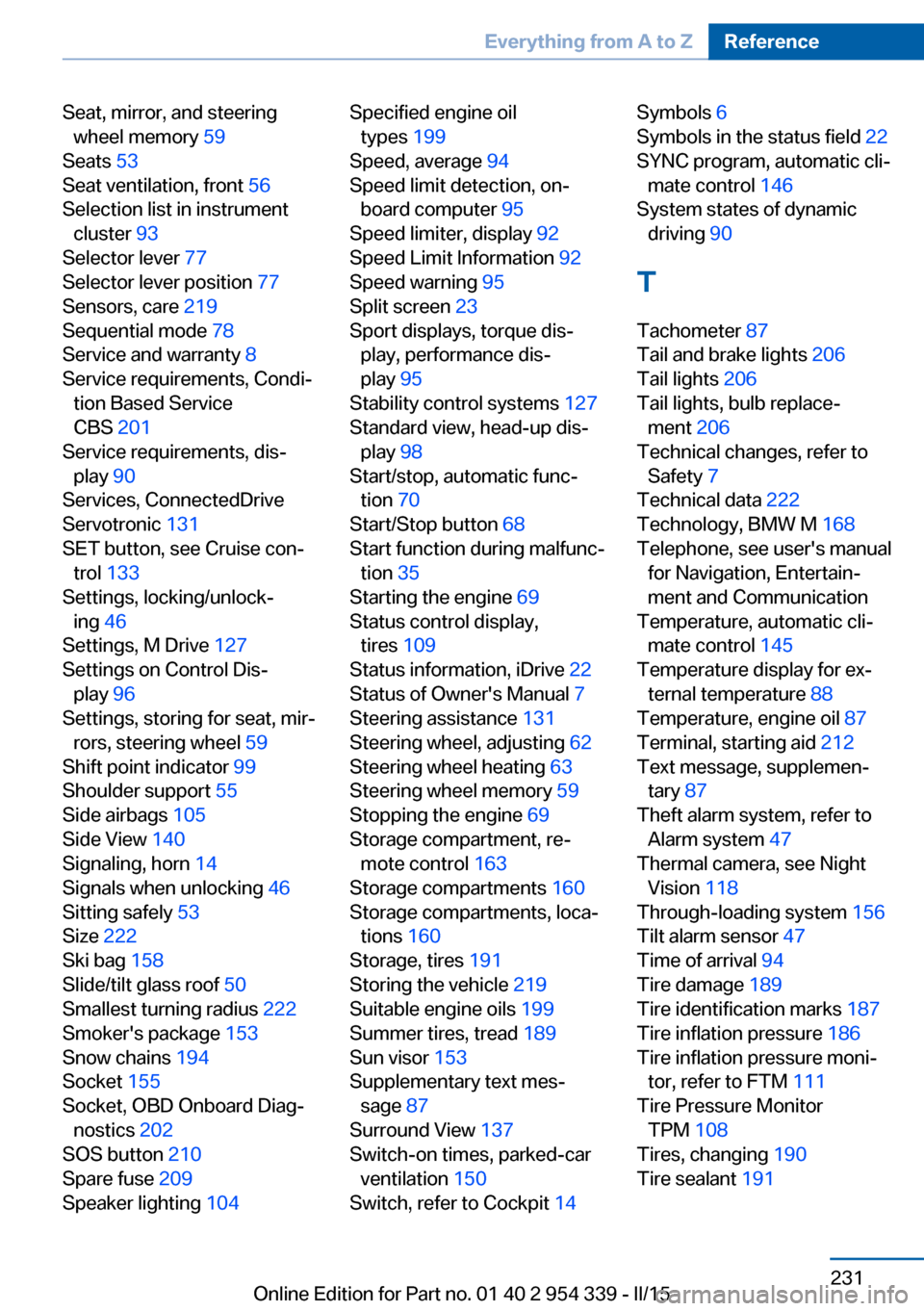
Seat, mirror, and steeringwheel memory 59
Seats 53
Seat ventilation, front 56
Selection list in instrument cluster 93
Selector lever 77
Selector lever position 77
Sensors, care 219
Sequential mode 78
Service and warranty 8
Service requirements, Condi‐ tion Based Service
CBS 201
Service requirements, dis‐ play 90
Services, ConnectedDrive
Servotronic 131
SET button, see Cruise con‐ trol 133
Settings, locking/unlock‐ ing 46
Settings, M Drive 127
Settings on Control Dis‐ play 96
Settings, storing for seat, mir‐ rors, steering wheel 59
Shift point indicator 99
Shoulder support 55
Side airbags 105
Side View 140
Signaling, horn 14
Signals when unlocking 46
Sitting safely 53
Size 222
Ski bag 158
Slide/tilt glass roof 50
Smallest turning radius 222
Smoker's package 153
Snow chains 194
Socket 155
Socket, OBD Onboard Diag‐ nostics 202
SOS button 210
Spare fuse 209
Speaker lighting 104 Specified engine oil
types 199
Speed, average 94
Speed limit detection, on- board computer 95
Speed limiter, display 92
Speed Limit Information 92
Speed warning 95
Split screen 23
Sport displays, torque dis‐ play, performance dis‐
play 95
Stability control systems 127
Standard view, head-up dis‐ play 98
Start/stop, automatic func‐ tion 70
Start/Stop button 68
Start function during malfunc‐ tion 35
Starting the engine 69
Status control display, tires 109
Status information, iDrive 22
Status of Owner's Manual 7
Steering assistance 131
Steering wheel, adjusting 62
Steering wheel heating 63
Steering wheel memory 59
Stopping the engine 69
Storage compartment, re‐ mote control 163
Storage compartments 160
Storage compartments, loca‐ tions 160
Storage, tires 191
Storing the vehicle 219
Suitable engine oils 199
Summer tires, tread 189
Sun visor 153
Supplementary text mes‐ sage 87
Surround View 137
Switch-on times, parked-car ventilation 150
Switch, refer to Cockpit 14 Symbols 6
Symbols in the status field 22
SYNC program, automatic cli‐ mate control 146
System states of dynamic driving 90
T
Tachometer 87
Tail and brake lights 206
Tail lights 206
Tail lights, bulb replace‐ ment 206
Technical changes, refer to Safety 7
Technical data 222
Technology, BMW M 168
Telephone, see user's manual for Navigation, Entertain‐
ment and Communication
Temperature, automatic cli‐ mate control 145
Temperature display for ex‐ ternal temperature 88
Temperature, engine oil 87
Terminal, starting aid 212
Text message, supplemen‐ tary 87
Theft alarm system, refer to Alarm system 47
Thermal camera, see Night Vision 118
Through-loading system 156
Tilt alarm sensor 47
Time of arrival 94
Tire damage 189
Tire identification marks 187
Tire inflation pressure 186
Tire inflation pressure moni‐ tor, refer to FTM 111
Tire Pressure Monitor TPM 108
Tires, changing 190
Tire sealant 191 Seite 231Everything from A to ZReference231
Online Edition for Part no. 01 40 2 954 339 - II/15